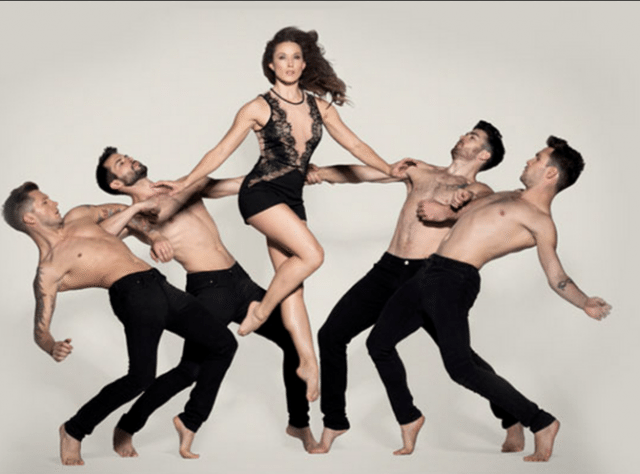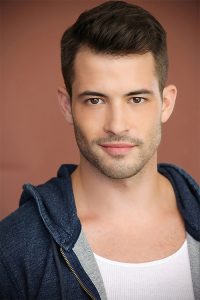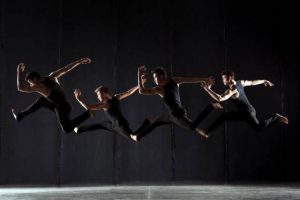
 If you’re familiar with the Oxygen network's All the Right Moves, you’ll be familiar with the name Kyle Robinson. The reality TV show chronicled the 2012 creation of Shaping Sound, an LA-based dance company with a focus on contemporary choreography. The company, co-founded by Robinson, Travis Wall, Nick Lazzarini, and Teddy Forance, has been on tour since October -- and though the schedule of a touring artist can be hectic, Kyle was kind enough to spend some time speaking with me about life on the road.
If you’re familiar with the Oxygen network's All the Right Moves, you’ll be familiar with the name Kyle Robinson. The reality TV show chronicled the 2012 creation of Shaping Sound, an LA-based dance company with a focus on contemporary choreography. The company, co-founded by Robinson, Travis Wall, Nick Lazzarini, and Teddy Forance, has been on tour since October -- and though the schedule of a touring artist can be hectic, Kyle was kind enough to spend some time speaking with me about life on the road.
Kyle, an outstanding (and, of course, incredibly handsome) dancer, is also an actor and singer who performed in the national tour of West Side Story. He has also appeared on Parks and Recreation as the male stripper “Babe Lincoln,” on So You Think You Can Dance, and in a Chase Bank/Lowe's commercial. Given the opportunity to interview Kyle, I wanted to find out what’s under the good looks and talent, and I was pleased to discover how intelligent, kind, and self-aware he is. This didn’t really come as a surprise given that he is a Juilliard grad and protégé of Mikhail Baryshnikov; if you’ve taken his class or stuck around after a show to meet him in the lobby while he’s doling out smiles and hugs to his fans, you’ve probably learned these things as well. Another thing I learned is that he’s thrilled to be back in NYC, his college stomping grounds of the Upper West Side, as Shaping Sound closes their tour at the Beacon Theater on February 8th. He’ll also be returning to Broadway Dance Center as guest faculty on February 11th.
 How has the tour been going so far?
How has the tour been going so far?
The tour is going great. The audiences have been phenomenal. We broke our record for tickets sold in Calgary, where I think we sold 27 hundred seats. So, it’s going well and we’re selling out, but for the show that we have, it’s a little tough on the body. So, I try to stay healthy and keep the show going.
You are finishing up the tour in New York where you have lived, studied and taught. Let’s say hypothetically you arrive and have plenty of time to do one thing specific to New York. What do you do?
I would love to go to Francesco’s on Columbus and 68th. It’s basically two avenues away from the Beacon. They have one of the best slices of pizza on the Upper West Side. I’ll definitely be stopping by there. Also, I have so many friends that I went to school with that I don’t get to see nearly enough, so I’ll be reaching out to all of them as well. I’m really looking forward to being back in New York for a little while.
So when myself, all of your friends, and everyone else in New York comes to see your show on the 8th…
(Laughs) The whole island!
...what can we expect from the Shaping Sound performance?
When I think of Shaping Sound, I think of high energy, explosive movement, and very musical. You can expect to see a good amount of acting and performing, actually. We have a full story line, so it’s along the lines of a story ballet meets rock opera. That’s how I usually describe it. We have a protagonist whom we follow through the hour and 45 minutes of the show. I’ve heard from dads that is actually a good show. So, that’s a good sign.
You’ve heard from dads? (Laughs) The guys that are usually snoozing through dance performances?
Yeah, (laughs) the fathers that are usually at home watching football. When they come with their daughters, they are actually quite thrilled with the performance. People see Shaping Sound posters, and they see Travis, Teddy, Nick, and I… and maybe Jaimie. But what they don’t see [from the posters] is that we have a full cast of 14 dancers: seven guys and seven girls. That stage is always full and there is always huge dance-life that is happening in front of you. Even when I watch the show sometimes, when we film it and watch it back so we can give ourselves corrections… even watching it on a TV screen, I still have a hard time deciding what I want to look at in some scenes because there are so many dancers on stage and it’s such a powerful visual.
Can you identify a moment in the show, aside from the general euphoria of performing, that is more magical than the others?
There is a moment in the show that is completely euphoric for me. It’s when most of my tough dancing and my portion of lifting is over. It’s in what we call “the boy’s piece” (aside from the main character who is played by Mallauri Esquibel this time around and who is phenomenal), the rest of the guys come out and they end up picking me up and manipulating my body after a whole show of me picking everyone else up. That’s my most euphoric part of the show. As far as my favorite part of the show to dance, we do this bit to Nina Simone’s "Wild is the Wind". It’s recently been shifted to where I’m dancing on stage for a good five minutes of a seven-minute song. Musically, I think it’s one of the most gorgeous pieces in the whole show. And I love Nina Simone. I think she’s so brilliant and such a beautiful artist.
You have extensive experience in ballet, modern dance, and musical theater dance. Years in the future, what about contemporary dance will this generation of dancers be known for?
I think this generation of dancers has been the most responsible for bringing about contemporary dance. Whereas Jose [Limon] and Martha [Graham] started modern dance and then [Merce] Cunningham and his constituents brought about post modern dance, I think for us it will be contemporary. Having a ballet and modern background and having dance history under my belt, I’ve had a tough time wrestling with the concept of “contemporary” because for me it feels like just an adjective to describe another style of dance, even though it has very much become its own style. When I teach, I think of my class as being more lyrical-modern or contemporary-modern; I don’t really think of it as just contemporary. The danger in just labeling it as contemporary is that it’s left open and very vague—it implies that it can be absolutely whatever instead of acknowledging that you need a technique or a vocabulary in order for a technique to be a technique. I think in what we’re doing, we are defining what that contemporary technique or what those contemporary movements are. I think we’re finally defining what contemporary dance is. And we’re finally finding and building a vocabulary, instead of it being so broadly labeled.
 So many young dancers are looking up to you as a role model. How does that change or inform your work?
So many young dancers are looking up to you as a role model. How does that change or inform your work?
It’s less in my work and more on a personal level—how I handle matters in that arena. If you think about what other people are going to think when you’re creating art, you’re censoring yourself, limiting yourself, or inhibiting yourself. So I try not to think of [being a role model] when I’m creating because it’s a detriment to my process. I counteract that by going out at the end of our shows, and I’m usually the last one in the lobby meeting and greeting people, taking pictures, and signing autographs. I ask people their names and am known for giving out hugs. For me, it’s taking the time to actually be a human and to be a good person—acknowledging your fans and the people who support you. I think that’s the most important thing you can do as an artist. Aside from continuously creating, and more than being a phenomenal dancer, it’s important to be a phenomenal human first and foremost. Be thankful and be genuine. That’s what I hope they take away.
A lot of dancers give up pursuing dance for more stability, family, education, the list goes on. What is something in your life you’ve sacrificed in order to pursue your dance career successfully?
There are plenty of things in my life I’ve sacrificed to be able to continue dancing. Early on, I was in musical theater when I first started dancing. I started taking [dance] classes because I couldn’t for the life of me remember a count of eight. It was during a production of Grease and it was like: chaînés step touch, chaînés step touch, step clap, step clap, step clap, step clap. And I couldn’t remember the order of it; I couldn’t get the chaînés together. I really loved acting and singing and my mom turns to me one day, when I was 11, and asked me if I wanted to take some dance classes; because if I wanted to be a triple-threat, I was going to have to learn how to dance. So I started dancing, and once you hit high school, it becomes more intense—I wasn’t able to do the acting and the productions anymore because I was training and competing in dance. Acting and singing was the first to go, but they’ve sort’ve made a resurgence since doing West Side Story. I also couldn’t find time for sports. I played football and lacrosse for a while but that soon went out the window. My dad was amazingly supportive throughout that, saying “as long as you love what you’re doing, go for it.” Aside from that, I’ve sacrificed trips with friends and I feel that some of my personal relationships have suffered because being on the road isn’t easy on a relationship. With any art, you’ve got to give it a lot of yourself. Sacrifices do happen, even if you don’t intend for them to. It’s tough and it’s tough being a traveling artist especially. Maybe that’s why people decide to pursue other things and more consistent pay checks. But I’ll be dancing or singing until the day I die.
And acting?
And acting, yes. Dancing, acting, and singing is the layout—I’ll be doing a little bit of dancing, transitioning into some acting, a little bit more acting… and when I’m old and gray and the knees don’t want to work anymore, I’m going to be a big band lounge singer. That’ll be my final act, out of my love for Frank and Dean and the whole Rat Pack.
Shaping Sound performs at the Beacon on February 8th. For more information visit: https://www.shapingsoundco.com/